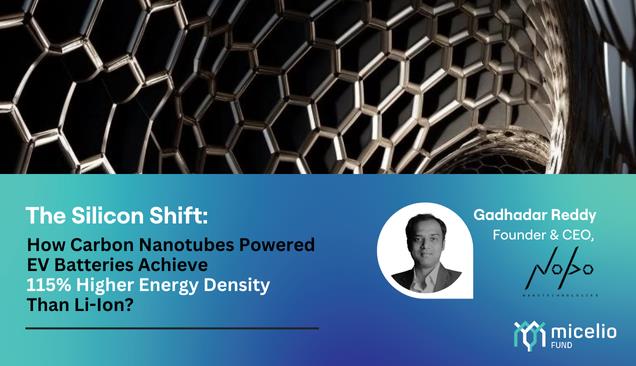The Silicon Shift: How Carbon Nanotubes Powered EV Batteries Achieve 115% Higher Energy Density Than Li-Ion?
Electric vehicles (EVs) are only as good as their batteries. Today’s EVs mostly run on lithium-ion batteries – a proven technology but one nearing its performance limits. Enter carbon nanotubes: tiny, tube-shaped carbon structures one atom thick (imagine graphene sheets rolled into microscopic straws). These nanotubes, with extraordinary strength and conductivity, promise to supercharge the next generation of EV batteries. In this post, we compare nanotube-enhanced EV batteries with traditional lithium-ion batteries in terms of performance.

Performance Comparison
When it comes to powering EVs, performance is king. How do nanotube-infused batteries stack up against the lithium-ion batteries in today’s cars? Let’s break it down by specific performance metrics:
- Energy Density (How Much Energy a Battery Holds):
Traditional lithium-ion EV batteries have energy densities around 150-250 Wh/kg (watt-hours per kilogram) in commercial cells, enabling driving ranges of a few hundred kilometers per charge. Cutting-edge cells can reach ~300 Wh/kg in the lab. Single wall carbon nanotube battery technology aims to push these numbers even higher. By incorporating carbon nanotubes into battery electrodes, researchers have enabled new materials like silicon anodes that can dramatically increase capacity. For instance, adding single-wall nanotubes lets battery makers use silicon in the anode (replacing graphite), achieving energy densities of 600-650 Wh/kg – roughly 115% higher than the best current Li-ion cells.
- Charging Speed:
“Fast charging” for today’s EVs usually means ~30 minutes to reach 80% charge on a high-power DC station – not exactly instant. Nanotube-enhanced batteries could slash charging times dramatically. How? Nanotubes create a highway for ions and electrons (“World’s fastest electrodes” triple the density of lithium batteries) The orderly nano-structure shortens the distance ions need to travel inside the electrode, reducing resistance and heat. In practical terms, this means less time waiting at the charger and more time on the road. It’s not just startups making progress; even academic labs have shown improvements. Researchers at Rice University found that coating a lithium metal anode with a film of carbon nanotubes allowed safe ultra-fast charging without harmful dendrites (metal filaments) forming. This could enable future batteries that recharge in minutes.
- Lifespan (Cycle Life):
EV batteries need to last for years and hundreds of thousands of miles. Traditional lithium-ion packs typically endure 1,000 or so charge cycles before their capacity noticeably drops (many cars still retain ~80% capacity after 8-10 years). Nanotube technology could extend battery longevity significantly. The robust, flexible network formed by nanotubes can accommodate the swelling of high-capacity materials like silicon, preventing cracks and degradation. In fact, nanotube-enhanced silicon anodes have demonstrated up to 4× longer cycle life than silicon alone. Imagine a battery that easily outlives the car itself or handles a million miles of driving. While real-world results are still forthcoming, early signs indicate nanotubes can dramatically reduce wear and capacity loss, even under fast charging stress.
- Thermal Stability and Safety:
Anyone who’s heard of smartphone or EV battery fires knows lithium-ion batteries have a thermal runaway risk if abused or overheated. Traditional EV batteries are generally safe thanks to advanced management systems, but high currents or damage can generate intense heat. Here, nanotubes offer two advantages. First, carbon nanotubes have excellent thermal conductivity, helping dissipate heat more evenly through the cell. This means a nanotube-infused electrode can pull heat away from hot spots much faster than a conventional battery. Overall, nanotube-enhanced batteries are expected to run cooler and be more resistant to thermal runaway, making EV’s safer.
- Overall Efficiency:
Battery efficiency can refer to how well a battery accepts and delivers charge (Coulombic efficiency) and how little energy is lost as heat. Traditional lithium-ion cells are already quite efficient (often 95-99% Coulombic efficiency per cycle), but high charging or discharging rates can waste energy as heat. Nanotube-based electrodes, with their superior electrical conductivity, minimize internal resistance. This leads to higher round-trip efficiency – more of the energy you put in comes back out as usable power. For example, the nanotube-protected lithium metal anode at Rice maintained an impressive 99.8% efficiency over hundreds of cycles. In practical terms, a more efficient battery means less energy wasted during charging/discharging and slightly more miles per kWh. The battery stays healthier longer, as less heat and stress are generated inside. So while “efficiency” is less visible to the driver than range or charging speed, nanotubes help ensure every bit of energy is used effectively, boosting the battery’s overall performance envelope.
In summary, nanotube-enhanced EV batteries aim to outshine today’s lithium-ion packs across the board: packing in more energy, charging faster, lasting longer, and running cooler and more efficiently. It’s like giving the battery a nanotech overhaul – using atomic-scale carbon structures to solve macro-scale problems. The race for better EV batteries is on, and nanotubes are giving engineers a powerful new tool to push the boundaries. For consumers and climate advocates, the prospect of affordable EVs with 1000km range, 5-minute charging, and 15-year batteries is incredibly exciting. For investors, the companies mastering nanotube battery tech could be the lynchpins of the next automotive revolution. While traditional lithium-ion batteries have served us well, the future points to batteries that are stronger, faster, and greener – and nanotubes are the tiny heroes making it possible.
(Disclaimer: The views expressed here are solely of the expert. Micelio does not claim ownership and serves only as a platform to share insights from industry leaders)
*****************************************
About Expert:
Gadhadhar Reddy
Founder & CEO, Nopo Nanotechnologies
With 22 years in technology, Gadhadar Reddy has pioneered electronic waste management solutions across India, the US, and GCC. He has led India to global prominence in the production of HiPCO® Single Walled Carbon Nanotubes (SWCNTs), revolutionizing industries such as space, defense, water, and electronics. His breakthrough work at NoPo Nanotechnologies has set industry standards, earning the company recognition as one of the world’s top SWCNT manufacturers.


